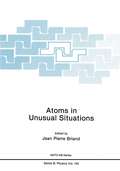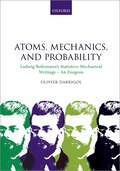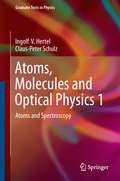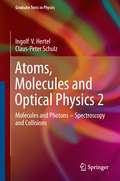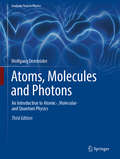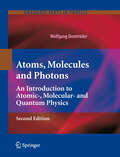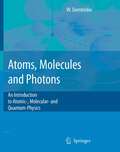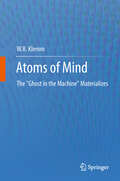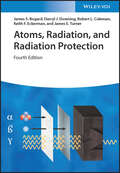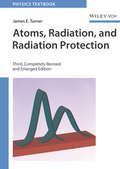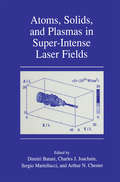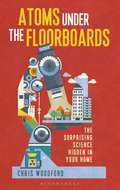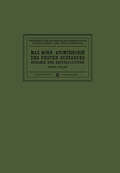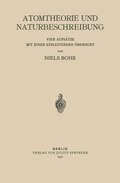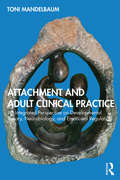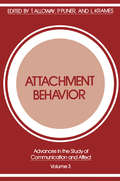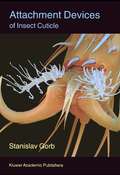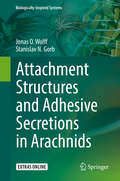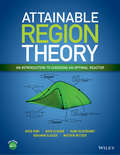- Table View
- List View
Atoms in Unusual Situations (Nato Science Series B: #143)
by Jean P. BriandAtomic Physics is certainly the oldest field in which Quantum Mechanics has been used and has provided the most significant proofs of this new theory. Most of the basic concepts, except those more recently developed in field quantization, have been understood for quite a time. Atomic Physics began to serve as a basis for other fields such as molecu lar, solid state or nuclear physics. A renewal of interest in Atomic Physics began in the sixties, after the discovery of Quantum Electro dynamics, and later when it provided some basic tests of fundamental questions like parity violation, time reversal or Dirac theory. More recently the development of new technologies led to the ex ploration of very extreme cases in which the most secrete aspects of atoms have been observed. - Rydberg states where the atoms are so big that they can be described by classical theories; - Heavy or super-heavy ions or exotic atoms where unknown QED or relativistic effects can be observed (very heavy hydrogenlike or helium like ions, positron production in very violent collisions ••. ); - Huge external perturbations as those appearing in super-dense plasmas or ultra-high fields. The aim of this school was to gather atomic physicists from all over the world working in all these areas of Atomic Physics.
Atoms, Mechanics, and Probability: Ludwig Boltzmann's Statistico-Mechanical Writings - An Exegesis
by Olivier DarrigolOne of the pillars of modern science, statistical mechanics, owes much to one man, the Austrian physicist Ludwig Boltzmann (1844-1906). As a result of his unusual working and writing styles, his enormous contribution remains little read and poorly understood. The purpose of this book is to make the Boltzmann corpus more accessible to physicists, philosophers, and historians, and so give it new life. The means are introductory biographical and historical materials, detailed and lucid summaries of every relevant publication, and a final chapter of critical synthesis. Special attention is given to Boltzmann's theoretical tool-box and to his patient construction of lofty formal systems even before their full conceptual import could be known. This constructive tendency largely accounts for his lengthy style, for the abundance of new constructions, for the relative vagueness of their object—and for the puzzlement of commentators. This book will help the reader cross the stylistic barrier and see how ingeniously Boltzmann combined atoms, mechanics, and probability to invent new bridges between the micro- and macro-worlds.
Atoms, Molecules and Optical Physics 1: Atoms and Spectroscopy (Graduate Texts in Physics)
by Ingolf V. Hertel Claus-Peter SchulzThis is the first volume of textbooks on atomic, molecular and optical physics, aiming at a comprehensive presentation of this highly productive branch of modern physics as an indispensable basis for many areas in physics and chemistry as well as in state of the art bio- and material-sciences. It primarily addresses advanced students (including PhD students), but in a number of selected subject areas the reader is lead up to the frontiers of present research. Thus even the active scientist is addressed. This volume 1 provides the canonical knowledge in atomic physics together with basics of modern spectroscopy. Starting from the fundamentals of quantum physics, the reader is familiarized in well structured chapters step by step with the most important phenomena, models and measuring techniques. The emphasis is always on the experiment and its interpretation, while the necessary theory is introduced from this perspective in a compact and occasionally somewhat heuristic manner, easy to follow even for beginners.
Atoms, Molecules and Optical Physics 2: Molecules and Photons - Spectroscopy and Collisions (Graduate Texts in Physics)
by Ingolf V. Hertel Claus-Peter SchulzThis is the second volume of textbooks on atomic, molecular and optical physics, aiming at a comprehensive presentation of this highly productive branch of modern physics as an indispensable basis for many areas in physics and chemistry as well as in state of the art bio- and material-sciences. It primarily addresses advanced students (including PhD students), but in a number of selected subject areas the reader is lead up to the frontiers of present research. Thus even the active scientist is addressed. This volume 2 introduces lasers and quantum optics, while the main focus is on the structure of molecules and their spectroscopy, as well as on collision physics as the continuum counterpart to bound molecular states. The emphasis is always on the experiment and its interpretation, while the necessary theory is introduced from this perspective in a compact and occasionally somewhat heuristic manner, easy to follow even for beginners.
Atoms, Molecules and Photons: An Introduction to Atomic-, Molecular- and Quantum Physics (Graduate Texts in Physics)
by Wolfgang DemtröderThis introduction to Atomic and Molecular Physics explains how our present model of atoms and molecules has been developed over the last two centuries both by many experimental discoveries and, from the theoretical side, by the introduction of quantum physics to the adequate description of micro-particles. It illustrates the wave model of particles by many examples and shows the limits of classical description. The interaction of electromagnetic radiation with atoms and molecules and its potential for spectroscopy is outlined in more detail and in particular lasers as modern spectroscopic tools are discussed more thoroughly. Many examples and problems with solutions are offered to encourage readers to actively engage in applying and adapting the fundamental physics presented in this textbook to specific situations.Completely revised third edition with new sections covering all actual developments, like photonics, ultrashort lasers, ultraprecise frequency combs, free electron lasers, cooling and trapping of atoms, quantum optics and quantum information.
Atoms, Molecules and Photons: An Introduction to Atomic-, Molecular- and Quantum Physics (Graduate Texts in Physics)
by Wolfgang DemtröderThis introduction to Atomic and Molecular Physics explains how our present model of atoms and molecules has been developed during the last two centuries by many experimental discoveries and from the theoretical side by the introduction of quantum physics to the adequate description of micro-particles. It illustrates the wave model of particles by many examples and shows the limits of classical description. The interaction of electromagnetic radiation with atoms and molecules and its potential for spectroscopy is outlined in more detail and in particular lasers as modern spectroscopic tools are discussed more thoroughly. Many examples and problems with solutions should induce the reader to an intense active cooperation.
Atoms, Molecules and Photons: An Introduction to Atomic- Molecular- and Quantum Physics
by Wolfgang DemtröderThis introduction to Atomic and Molecular Physics explains how our present model of atoms and molecules has been developed during the last two centuries by many experimental discoveries and from the theoretical side by the introduction of quantum physics to the adequate description of micro-particles. It illustrates the wave model of particles by many examples and shows the limits of classical description. The interaction of electromagnetic radiation with atoms and molecules and its potential for spectroscopy is outlined in more detail and in particular lasers as modern spectroscopic tools are discussed more thoroughly. Many examples and problems with solutions should induce the reader to an intense active cooperation.
Atoms of Mind: The "Ghost in the Machine" Materializes
by W.R. KlemmThis book describes the author’s view of how the mind “thinks” at various levels of operation. These levels include nonconscious mind (as in spinal/brainstem reflexes and neuroendocrine controls), subconscious mind, and conscious mind. In the attempt to explain conscious mind, there is considerable critique of arguments over whether or not free will is an illusion. Finally, the author summarizes current leading theories for consciousness (Bayesian probability, chaos, and quantum mechanics) and then presents his own theory based on patterns of nerve impulses in circuits that are interlaced coherently into larger networks.
Atoms of pure iron, and iron and carbon alloy (tactile)
by RnibThis diagram shows atoms of pure iron, and iron and carbon alloy. Page 1 shows the atoms of pure iron with arrows to shows how they can move around. Page 2 shows the atoms of an iron carbon alloy. The large circles are the iron atoms and the small circles are the carbon atoms.
Atoms, Radiation, and Radiation Protection
by James S. Bogard Darryl J. Downing Robert L. Coleman Keith F. Eckerman James E. TurnerAtoms, Radiation, and Radiation Protection Discover the keys to radiation protection in the fourth edition of this best-selling textbook A variety of atomic and sub-atomic processes, including alpha, beta, and gamma decay or electron ejection from inner atom shells, can produce ionizing radiation. This radiation can in turn produce environmental and biological effects both harmful – including DNA damage and other impacts of so-called ‘radiation sickness’ – and helpful, including radiation treatment for cancerous tumors. Understanding the processes that generate radiation and the steps which can be taken to mitigate or direct its effects is therefore critical in a wide range of industries and medical subfields. For decades, Atoms, Radiation, and Radiation Protection has served as the classic reference work on the subject of ionizing radiation and its safeguards. Beginning with a presentation of fundamental atomic structure and the physical mechanisms which produce radiation, the book also includes thorough discussion of how radiation can be detected and measured, as well as guide-lines for interpreting radiation statistics and detailed analysis of protective measures, both individual and environmental. Now updated by a new generation of leading scholars and researchers, Atoms, Radiation, and Radiation Protection will continue to serve global scientific and industrial research communities. Readers of the fourth edition of Atoms, Radiation, and Radiation Protection will also find: Detailed updates of existing material, including the latest recommendations of the ICRP and NCRP Treatment of current physiokinetic and dosimetric models All statistics now presented in SI units, making the book more globally accessible Atoms, Radiation, and Radiation Protection is a foundational guide for graduate students and researchers in health physics and nuclear physics, as well as related industries.
Atoms, Radiation, and Radiation Protection
by James S. Bogard Darryl J. Downing Robert L. Coleman Keith F. Eckerman James E. TurnerAtoms, Radiation, and Radiation Protection Discover the keys to radiation protection in the fourth edition of this best-selling textbook A variety of atomic and sub-atomic processes, including alpha, beta, and gamma decay or electron ejection from inner atom shells, can produce ionizing radiation. This radiation can in turn produce environmental and biological effects both harmful – including DNA damage and other impacts of so-called ‘radiation sickness’ – and helpful, including radiation treatment for cancerous tumors. Understanding the processes that generate radiation and the steps which can be taken to mitigate or direct its effects is therefore critical in a wide range of industries and medical subfields. For decades, Atoms, Radiation, and Radiation Protection has served as the classic reference work on the subject of ionizing radiation and its safeguards. Beginning with a presentation of fundamental atomic structure and the physical mechanisms which produce radiation, the book also includes thorough discussion of how radiation can be detected and measured, as well as guide-lines for interpreting radiation statistics and detailed analysis of protective measures, both individual and environmental. Now updated by a new generation of leading scholars and researchers, Atoms, Radiation, and Radiation Protection will continue to serve global scientific and industrial research communities. Readers of the fourth edition of Atoms, Radiation, and Radiation Protection will also find: Detailed updates of existing material, including the latest recommendations of the ICRP and NCRP Treatment of current physiokinetic and dosimetric models All statistics now presented in SI units, making the book more globally accessible Atoms, Radiation, and Radiation Protection is a foundational guide for graduate students and researchers in health physics and nuclear physics, as well as related industries.
Atoms, Radiation, and Radiation Protection
by James E. TurnerAtoms, Radiation, and Radiation Protection offers professionals and advanced students a comprehensive coverage of the major concepts that underlie the origins and transport of ionizing radiation in matter. Understanding atomic structure and the physical mechanisms of radiation interactions is the foundation on which much of the current practice of radiological health protection is based. The work covers the detection and measurement of radiation and the statistical interpretation of the data. The procedures that are used to protect man and the environment from the potential harmful effects of radiation are thoroughly described. Basic principles are illustrated with an abundance of worked examples that exemplify practical applications. Chapters include problem sets (with partial answers) and extensive tables and graphs for continued use as a reference work. This completely revised and enlarged third edition includes thorough updates of the material, including the latest recommendations of the ICRP and NCRP.
Atoms, Solids, and Plasmas in Super-Intense Laser Fields
by Dimitri Batani Charles J. Joachain S. Martellucci Arthur N. ChesterThe recent developement of high power lasers, delivering femtosecond pulses of 20 2 intensities up to 10 W/cm , has led to the discovery of new phenomena in laser interactions with matter. At these enormous laser intensities, atoms, and molecules are exposed to extreme conditions and new phenomena occur, such as the very rapid multi photon ionization of atomic systems, the emission by these systems of very high order harmonics of the exciting laser light, the Coulomb explosion of molecules, and the acceleration of electrons close to the velocity of light. These phenomena generate new behaviour of bulk matter in intense laser fields, with great potential for wide ranging applications which include the study of ultra-fast processes, the development of high-frequency lasers, and the investigation of the properties of plasmas and condensed matter under extreme conditions of temperature and pressure. In particular, the concept of the "fast ignitor" approach to inertial confinement fusion (ICF) has been proposed, which is based on the separation of the compression and the ignition phases in laser-driven ICF. The aim of this course on "Atom, Solids and Plasmas in Super-Intense Laser fields" was to bring together senior researchers and students in atomic and molecular physics, laser physics, condensed matter and plasma physics, in order to review recent developments in high-intensity laser-matter interactions. The course was held at the Ettore Majorana International Centre for Scientific Culture in Erice from July 8 to July 14,2000.
Atoms - Structure of an Atom (tactile)
by RnibThis is a simple diagram of the atom showing the nucleus and electrons.
Atoms Under the Floorboards: The Surprising Science Hidden in Your Home
by Chris WoodfordUsing the modern home as a springboard, Atoms under the Floorboards introduces the reader to the fascinating and surprising scientific explanations behind a variety of common (and often entertainingly mundane) household phenomena, from gurgling drains and squeaky floorboards to rubbery custard and shiny shoes. Packed with facts and fun, each chapter focuses on a feature in each of the areas and slowly unpicks the science behind it.* Is it better to build skyscrapers like wobbly jellies or stacks of biscuits? *Can you burn your house down with an electric drill? *How many atoms would you have to split to power a lightbulb? *How can a raincoat be waterproof and breathable at the same time? Atoms under the Floorboards answers all these questions, and hundreds more. You'll never look at your home the same way again ...
Atoms Under the Floorboards: The Surprising Science Hidden in Your Home
by Chris WoodfordUsing the modern home as a springboard, Atoms under the Floorboards introduces the reader to the fascinating and surprising scientific explanations behind a variety of common (and often entertainingly mundane) household phenomena, from gurgling drains and squeaky floorboards to rubbery custard and shiny shoes. Packed with facts and fun, each chapter focuses on a feature in each of the areas and slowly unpicks the science behind it.* Is it better to build skyscrapers like wobbly jellies or stacks of biscuits? *Can you burn your house down with an electric drill? *How many atoms would you have to split to power a lightbulb? *How can a raincoat be waterproof and breathable at the same time? Atoms under the Floorboards answers all these questions, and hundreds more. You'll never look at your home the same way again ...
Atomtheorie des Festen Zustandes (Fortschritte der mathematischen Wissenschaften in Monographien)
by Max BornDieser Buchtitel ist Teil des Digitalisierungsprojekts Springer Book Archives mit Publikationen, die seit den Anfängen des Verlags von 1842 erschienen sind. Der Verlag stellt mit diesem Archiv Quellen für die historische wie auch die disziplingeschichtliche Forschung zur Verfügung, die jeweils im historischen Kontext betrachtet werden müssen. Dieser Titel erschien in der Zeit vor 1945 und wird daher in seiner zeittypischen politisch-ideologischen Ausrichtung vom Verlag nicht beworben.
Atomtheorie und Naturbeschreibung
by Niels BohrDieser Buchtitel ist Teil des Digitalisierungsprojekts Springer Book Archives mit Publikationen, die seit den Anfängen des Verlags von 1842 erschienen sind. Der Verlag stellt mit diesem Archiv Quellen für die historische wie auch die disziplingeschichtliche Forschung zur Verfügung, die jeweils im historischen Kontext betrachtet werden müssen. Dieser Titel erschien in der Zeit vor 1945 und wird daher in seiner zeittypischen politisch-ideologischen Ausrichtung vom Verlag nicht beworben.
Attachment and Adult Clinical Practice: An Integrated Perspective on Developmental Theory, Neurobiology, and Emotional Regulation
by Toni MandelbaumThis comprehensive volume addresses attachment theory’s history as well as its integration with neurobiology, psychophysiology, theories of emotion, regulation theory, and mentalization theory. It explores how clinicians can connect with their clients so that they feel completely seen and heard. Attachment theory speaks to one’s biological drive to connect, to relate, and to feel heard. The author aims to achieve this by condensing the enormous and diverse literature of the field into a singular, manageable work that clinicians can use to foster these connections. The book traces the history of attachment theory and describes how neurobiological research has influenced the expansion of attachment theory, and how emotions and psychophysiology have become critical to our understanding of human attachment connections. It concludes with a detailed examination of how to apply these theories in clinical practice. This practical book addresses attachment theory’s take on integrating the mind, body, and emotion when striving toward well-being. It will be of great importance for psychotherapy students, beginning therapists, and experienced clinicians with an interest in attachment theory.
Attachment and Adult Clinical Practice: An Integrated Perspective on Developmental Theory, Neurobiology, and Emotional Regulation
by Toni MandelbaumThis comprehensive volume addresses attachment theory’s history as well as its integration with neurobiology, psychophysiology, theories of emotion, regulation theory, and mentalization theory. It explores how clinicians can connect with their clients so that they feel completely seen and heard. Attachment theory speaks to one’s biological drive to connect, to relate, and to feel heard. The author aims to achieve this by condensing the enormous and diverse literature of the field into a singular, manageable work that clinicians can use to foster these connections. The book traces the history of attachment theory and describes how neurobiological research has influenced the expansion of attachment theory, and how emotions and psychophysiology have become critical to our understanding of human attachment connections. It concludes with a detailed examination of how to apply these theories in clinical practice. This practical book addresses attachment theory’s take on integrating the mind, body, and emotion when striving toward well-being. It will be of great importance for psychotherapy students, beginning therapists, and experienced clinicians with an interest in attachment theory.
Attachment Devices of Insect Cuticle
by Stanislav S. GorbIn 1974 when I published my book, Biological Mechanism of Attachment, not many pages were required to report on the attachment devices of insect cuticles. As in most fields of research, our knowledge on this specific subject has simply exploded. Dr. Stanislav N. Gorb now describes the present day level of our knowledge, to which he has personally contributed so much, and a research team working on biological microtribology has gradually developed, also. With modern methods of measurement it is possible to enter the structure – function relationship much more deeply, even down to a molecular level, which was not possible two and a half decades ago. It is a well known fact that, in biology, the more sophisticated the measuring method, the greater the achievement of biological fundamental research, and its resulting evidence. Our knowledge remains at a certain level until new methods once more permit a forward leap. Biological knowledge develops in the form of a stepped curve rather than linear, as reflected in the studies carried out on the attachment devices of insect cuticles.
Attachment Structures and Adhesive Secretions in Arachnids (Biologically-Inspired Systems #7)
by Jonas O. Wolff Stanislav N. GorbThis book surveys attachment structures and adhesive secretions occurring in this class of animals and discusses the relationships between structure, properties, and function in the context of evolutionary trends, and biomimetic potential. Topics comprise mechanical attachment devices, such as clamps, claws, hooks, spines and wraps, as well as hairy and smooth adhesive pads, nano-fibrils, suction cups, and viscid and solidifying adhesives. Attachment is one of the major types of interactions between an organism and its environment. There are numerous studies that deal with this phenomenon in lizards, frogs, insects, barnacles, mussels and echinoderms, but the second largest class of animals, the Arachnida, was highly neglected so far. The authors demonstrated that most arachnid adhesive structures are highly analogous to those of insects and vertebrates, but there are also numerous unique developments with some intriguing working principles. Because arachnid attachment organs have a very strong potential of technological ideas for the development of new materials and systems, inspirations from biology could also be interesting for a broad range of topics in materials and surface engineering.
Attainable Region Theory: An Introduction to Choosing an Optimal Reactor
by David Ming David Glasser Diane Hildebrandt Benjamin Glasser Matthew MetgzerRecipient of the 2019 Most Promising New Textbook Award from the Textbook & Academic Authors Association (TAA)."The authors of Attainable Region Theory: An Introduction to an Choosing Optimal Reactor make what is a complex subject and decades of research accessible to the target audience in a compelling narrative with numerous examples of real-world applications." TAA Award Judges, February 2019Learn how to effectively interpret, select and optimize reactors for complex reactive systems, using Attainable Region theory Teaches how to effectively interpret, select and optimize reactors for complex reactive systems, using Attainable Region (AR) theory Written by co-founders and experienced practitioners of the theory Covers both the fundamentals of AR theory for readers new to the field, as we all as advanced AR topics for more advanced practitioners for understanding and improving realistic reactor systems Includes over 200 illustrations and 70 worked examples explaining how AR theory can be applied to complex reactor networks, making it ideal for instructors and self-study Interactive software tools and examples written for the book help to demonstrate the concepts and encourage exploration of the ideas
Attainable Region Theory: An Introduction to Choosing an Optimal Reactor
by David Ming David Glasser Diane Hildebrandt Benjamin Glasser Matthew MetgzerRecipient of the 2019 Most Promising New Textbook Award from the Textbook & Academic Authors Association (TAA)."The authors of Attainable Region Theory: An Introduction to an Choosing Optimal Reactor make what is a complex subject and decades of research accessible to the target audience in a compelling narrative with numerous examples of real-world applications." TAA Award Judges, February 2019Learn how to effectively interpret, select and optimize reactors for complex reactive systems, using Attainable Region theory Teaches how to effectively interpret, select and optimize reactors for complex reactive systems, using Attainable Region (AR) theory Written by co-founders and experienced practitioners of the theory Covers both the fundamentals of AR theory for readers new to the field, as we all as advanced AR topics for more advanced practitioners for understanding and improving realistic reactor systems Includes over 200 illustrations and 70 worked examples explaining how AR theory can be applied to complex reactor networks, making it ideal for instructors and self-study Interactive software tools and examples written for the book help to demonstrate the concepts and encourage exploration of the ideas
